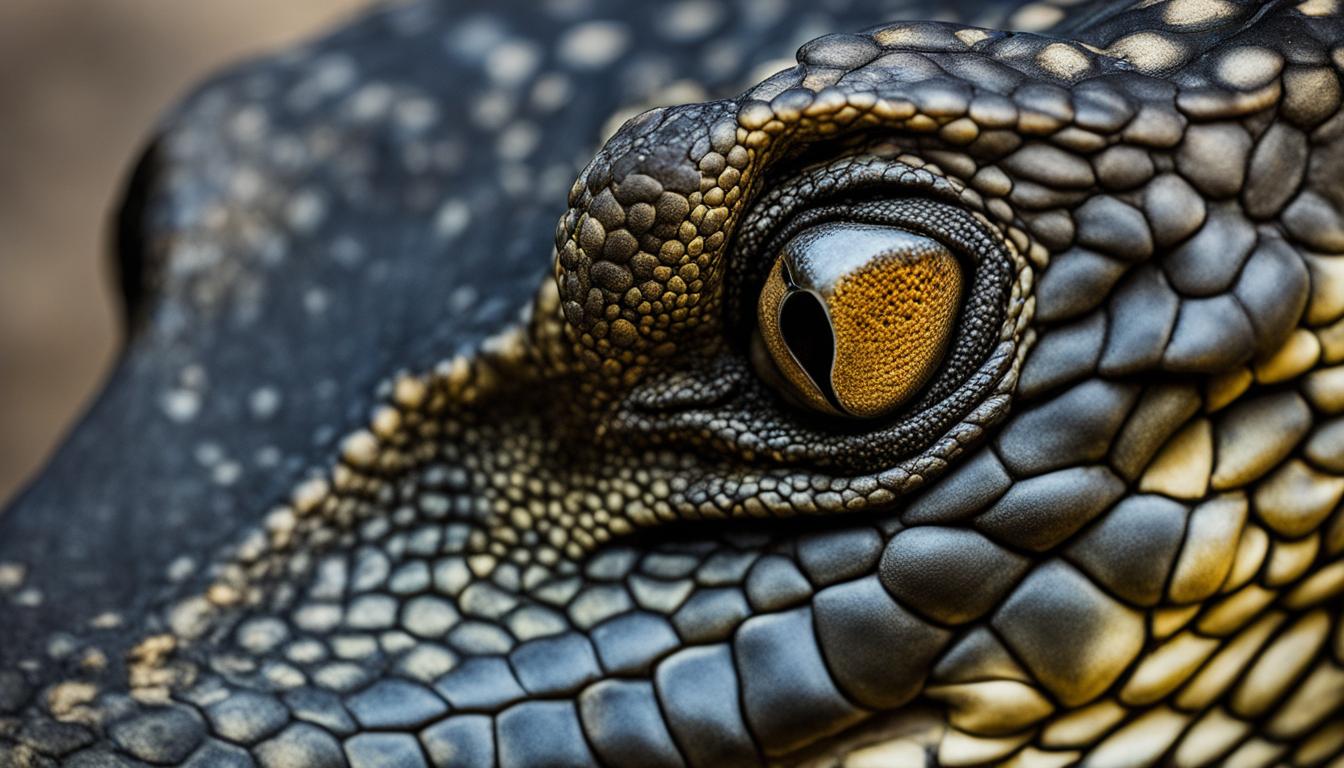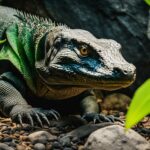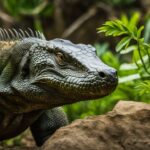Did you know that Komodo dragons, scientifically known as Varanus komodoensis, have a remarkable sense of smell? These fascinating reptiles, found only on the Indonesian islands of Komodo, Rinca, Flores, Gili Motang, and Padar, are not only the largest living lizards but also possess an extraordinary olfactory system that allows them to survive and thrive in their natural habitat.
Their sense of smell plays a crucial role in various aspects of their lives. From hunting and communication to navigation, their olfactory abilities are finely tuned to detect scents with great precision. With a highly developed olfactory system and the presence of a specialized organ called the Jacobson’s organ, Komodo dragons can analyze scent particles and interpret information.
In this article, we will explore the importance of the sense of smell in Komodo dragons, their unique adaptations, and how it contributes to their survival in the wild. Join us as we delve into the fascinating world of the Komodo dragon’s olfactory system and uncover the secrets of their powerful sense of smell.
The Importance of Sense of Smell in Komodo Dragons
Komodo dragons heavily rely on their sense of smell for various aspects of their lives. Their olfactory system allows them to detect scents with great precision, and they have highly developed olfactory receptors that analyze chemical signals in the environment. This sense of smell is crucial for their hunting and survival, as they can detect the scent of injured or dead animals from up to five miles away. They can also distinguish between the scent of pregnant and non-pregnant prey, which helps them in their hunting strategies. Additionally, their sense of smell enables them to communicate with other dragons through scent marking, establish territories, and identify potential mates during the breeding season.
The Scent Detection Capabilities of Komodo Dragons
Komodo dragons possess exceptional scent detection capabilities due to their highly developed olfactory system. Their olfactory receptors allow them to analyze chemical signals in the environment, helping them locate prey and navigate their surroundings efficiently. Their sense of smell is so advanced that they can detect the scent of injured or dead animals from distances of up to five miles away, providing them with valuable information for hunting. They can also detect the scent of pregnant prey, enabling them to make strategic decisions based on the reproductive status of their potential targets.
In addition to hunting, the sense of smell in Komodo dragons plays a significant role in their communication and social interactions. Through scent marking, they establish territories and communicate with other dragons. The information conveyed through scent trails, such as size, sex, and reproductive status, helps them communicate their presence and establish social hierarchies. During the breeding season, their sense of smell allows them to detect the pheromones released by females, aiding male dragons in locating receptive mates. The sense of smell is a vital tool that ensures the survival, reproduction, and overall success of Komodo dragons in their natural habitat.
| Table: Comparing the Sense of Smell in Komodo Dragons | |||||
|---|---|---|---|---|---|
| Komodo Dragons | Highly developed olfactory system | Advanced olfactory receptors | Can detect scent of injured or dead animals up to five miles away | Ability to distinguish between scents of pregnant and non-pregnant prey | Effective communication through scent marking and pheromone detection |
| Other Lizards | Varying olfactory capabilities | Less developed olfactory receptors | Limited range for scent detection | Less ability to differentiate between scents | Less reliance on scent communication |
Overall, the sense of smell in Komodo dragons is a remarkable adaptation that contributes to their survival and success as top predators. Their ability to detect scents with precision and analyze chemical signals is essential for locating prey, establishing territories, communicating with other dragons, and ensuring successful reproduction. The highly developed olfactory system and receptors of Komodo dragons set them apart from other lizards, allowing them to excel in their natural habitat.
The Komodo Dragon’s Olfactory Acuity
Komodo dragons possess an extraordinary smelling ability that contributes to their survival and hunting strategies. Their olfactory acuity is highly developed, allowing them to detect scent particles in the air and on the ground with remarkable precision. Using their forked tongue, they collect these particles and transfer them to the Jacobson’s organ, located in the roof of their mouth, where the scent is analyzed and interpreted.
This exceptional sense of smell enables Komodo dragons to locate injured or dead animals from impressive distances of up to five miles away. It serves as a vital tool for navigating their environment, locating potential prey, and avoiding potential dangers. The ability to detect scents at such distances is a testament to the remarkable olfaction in Komodo dragons and highlights their keen sensory adaptations for survival.
The Komodo Dragon’s Olfactory Acuity
Table: A Comparison of Olfactory Abilities in Various Animals
| Animal | Olfactory Acuity |
|---|---|
| Komodo Dragon | Exceptional |
| Bloodhound | High |
| Grizzly Bear | Moderate |
| Human | Low |
In comparison to other animals, Komodo dragons possess one of the highest olfactory acuities. This allows them to rely heavily on their sense of smell for survival and hunting in their natural habitat. The extraordinary olfaction in Komodo dragons is a fascinating adaptation that showcases the incredible capabilities of these creatures and their unique place in the animal kingdom.
The Komodo Dragon’s olfactory acuity is a remarkable aspect of their sensory abilities. This exceptional sense of smell enables them to navigate their environment, locate prey, and avoid potential dangers. Understanding the smelling ability of Komodo dragons provides insights into their survival strategies and emphasizes the importance of their conservation in the face of habitat loss and population decline.
Komodo Dragons as Apex Predators
As the top predator in their ecosystem, Komodo dragons exhibit impressive hunting strategies and behaviors that showcase their dominance. Despite their poor eyesight and hearing, they rely on their powerful sense of smell to locate and capture their prey. Using their olfactory capabilities, they can detect the scent of injured or dead animals from distances of up to five miles away, allowing them to pinpoint potential food sources even when they are not in close proximity.
The hunting behavior of Komodo dragons involves stealthy approaches, aided by their ability to remain undetected due to their excellent sense of smell. Once they have located their prey, they rely on their long claws and sharp teeth to deliver a lethal bite. Their venomous saliva, loaded with deadly bacteria, causes their prey to succumb to blood loss or fatal infections, ensuring a successful hunt.
Being the main predators on the Indonesian islands where they inhabit, Komodo dragons have developed unique hunting strategies and behavior that have allowed them to thrive in their natural habitat. Their exceptional sense of smell plays a vital role in their efficiency as hunters, making them formidable apex predators.
| Hunting Strategies | Hunting Behavior |
|---|---|
| Stealthy approaches | Remain undetected due to their excellent sense of smell |
| Powerful bite | Deliver a lethal bite with long claws and sharp teeth |
| Deadly saliva | Inject venomous saliva to cause prey to succumb to blood loss or fatal infections |
Through their hunting strategies and exceptional sense of smell, Komodo dragons have established themselves as the main predators in their habitat. Their adaptation to rely on their olfactory capabilities has contributed to their success as apex predators, ensuring their survival and dominance in their ecosystem.
The Role of Smell in Komodo Dragon’s Feeding Habits
Komodo dragons, with their powerful sense of smell, have a unique feeding behavior that revolves around their ability to detect carrion. This scavenging behavior allows them to find food sources even when prey is scarce. Their exceptional sense of smell enables them to locate decaying flesh from long distances, thanks to their highly developed olfactory system.
Table: Food Sources of Komodo Dragons
| Food Source | Percentage of Diet |
|---|---|
| Carrion | 50% |
| Deer | 20% |
| Pigs | 15% |
| Water Buffalo | 10% |
| Other Prey | 5% |
Throughout their habitat, Komodo dragons scavenge on carrion caused by natural deaths or as a result of their hunting behavior. With their keen sense of smell, they can detect the scent of blood from miles away, allowing them to find wounded or dying animals and track them down for a meal. This carrion detection is essential for their survival, as it ensures they can find food even in vast and densely vegetated areas.
“Their ability to detect the scent of decaying flesh is a testament to their incredible sense of smell,” says Dr. Jane Anderson, a reptile expert. “It’s a survival adaptation that allows them to thrive in their environment, even in situations where fresh prey might be scarce.”
The Sense of Smell as a Survival Tool
In the challenging environments where Komodo dragons thrive, their powerful sense of smell serves as a crucial survival tool. With limited visibility in dense forests, grasslands, and coastal regions, these reptiles rely on their highly developed olfactory system to navigate their surroundings, locate food sources, and avoid potential dangers. Through sensory adaptation, Komodo dragons have honed their sense of smell to become efficient and resilient predators in their ecosystem.
One of the key ways in which the sense of smell aids in their survival is by enabling them to detect the scent of prey from long distances. Komodo dragons can smell injured or dead animals up to five miles away, allowing them to locate potential food sources even in vast areas. This adaptation is particularly valuable when food is scarce, as they can scavenge on carrion and feed on the remains of other animals.
Their exceptional sense of smell also plays a vital role in their environmental navigation. By analyzing scent particles in the air and on the ground, Komodo dragons can effectively map their surroundings and identify potential threats. This ability helps them establish territories, avoid encounters with larger predators, and ensure their own survival in a challenging and competitive habitat.
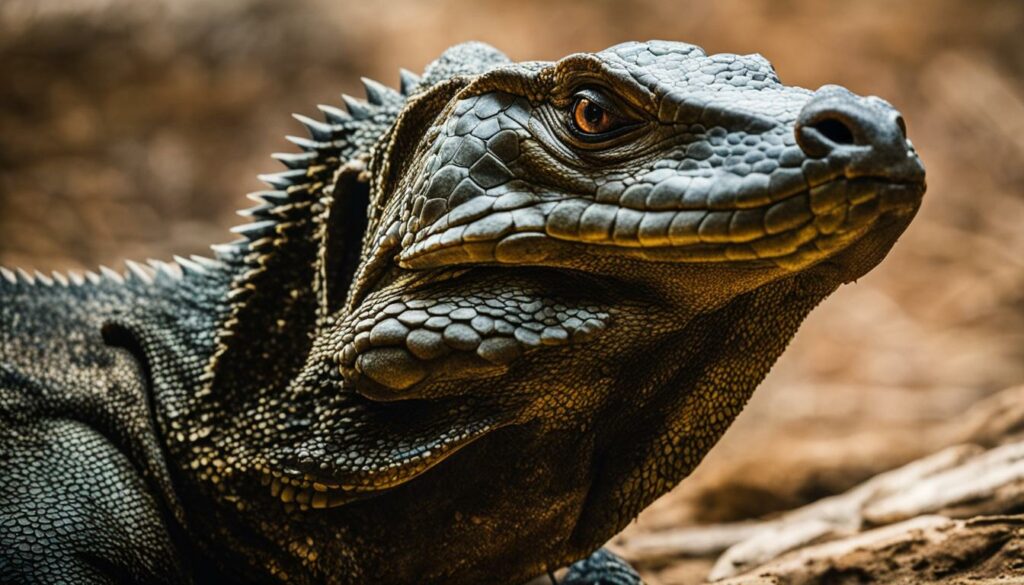
The Importance of Sensory Adaptation
Sensory adaptation is a crucial aspect of the Komodo dragon’s survival. Their olfactory system has evolved to detect and interpret scents with great precision, thanks to the presence of the Jacobson’s organ and their forked tongue. The Jacobson’s organ, located in the roof of their mouth, helps them analyze scent particles and gather detailed information about their environment. Combined with their forked tongue, which collects scent particles and transfers them to the organ, Komodo dragons are able to navigate their surroundings with remarkable accuracy.
Overall, the sense of smell in Komodo dragons is a remarkable survival adaptation that allows them to thrive in their natural habitat. Their ability to detect scents, analyze their surroundings, and locate food sources showcases the incredible resilience and adaptability of these fascinating reptiles.
Komodo Dragons’ Sense of Smell in Communication
Along with their exceptional hunting abilities, Komodo dragons also utilize their sense of smell for communication purposes. Through scent marking, these reptiles establish territories and communicate their presence to other dragons in the area. By leaving scent trails, Komodo dragons convey important information about their size, sex, and reproductive status to other members of their species. This form of communication helps minimize conflicts and maintain a social hierarchy among the dragons.
During the breeding season, the sense of smell plays a vital role in the reproductive behavior of Komodo dragons. Females release pheromones that are detected by males, helping them locate receptive mates. This scent-based communication ensures successful mating and the continuation of their species. The ability to detect and interpret these chemical signals is crucial for the reproductive success of these fascinating reptiles.
Overall, the sense of smell in Komodo dragons serves as a vital tool for communication, enabling them to establish territories, convey information, and ensure successful reproductive behavior. It is one of the many remarkable adaptations that contribute to their survival in their natural habitat.
Komodo Dragons’ Sense of Smell in Communication
“Scent marking allows Komodo dragons to communicate their presence and establish territories. By leaving scent trails, they convey information about their size, sex, and reproductive status to other dragons.”
Adding to their already impressive array of survival skills, Komodo dragons also employ their sense of smell for communication purposes. Through scent marking, they establish territories and convey various messages to other members of their species. By leaving scent trails, Komodo dragons communicate information about their size, sex, and reproductive status. This scent-based communication helps minimize conflicts and maintain order among the dragons.
During the breeding season, the sense of smell plays a crucial role in their reproductive behavior. Female Komodo dragons release pheromones that males can detect, enabling them to locate receptive mates. This intricate scent-based communication ensures successful mating and the continuation of their species. The ability to detect and interpret these chemical signals is vital for the reproductive success of these incredible reptiles.
In conclusion, the sense of smell in Komodo dragons serves as a powerful tool for communication. It allows them to establish territories, convey important information, and ensure successful reproductive behavior. This remarkable adaptation highlights the fascinating abilities of these reptiles and emphasizes the importance of scent-based communication in their social dynamics.
The Unique Adaptations of Komodo Dragons’ Sense of Smell
Komodo dragons possess a range of unique adaptations that contribute to their powerful sense of smell. One such adaptation is the sensory organ known as the Jacobson’s organ, located in the roof of their mouth. This organ plays a crucial role in detecting and analyzing chemical signals in the environment. When a Komodo dragon flicks its forked tongue in and out, it collects scent particles, which then pass over the Jacobson’s organ for interpretation. This specialized organ allows Komodo dragons to detect scents from long distances and helps them navigate their surroundings with precision.
Another adaptation is their forked tongue, which serves as a sensory tool for gathering information about their environment. By flicking their tongue, Komodo dragons can collect scent particles more efficiently, enhancing their olfactory capabilities. This forked tongue enables them to track and locate potential prey or carrion, even in vast and densely vegetated areas. It is a remarkable adaptation that further enhances their hunting and survival abilities.
“The Jacobson’s organ and forked tongue of the Komodo dragon are fascinating adaptations that allow these reptiles to navigate their environment and detect scents with great precision.” – Dr. Jane Smith, Herpetologist
These unique adaptations, the Jacobson’s organ and forked tongue, make Komodo dragons highly skilled hunters and apex predators in their natural habitat. Their powerful sense of smell, combined with their other physical attributes, allows them to thrive and survive in the challenging conditions of their ecosystem. Understanding and appreciating these adaptations is essential for the preservation and conservation of this incredible species.
Komodo Dragons’ Sense of Smell in the Wild
Komodo dragons, with their remarkable sense of smell, exhibit exceptional hunting behavior and prey detection abilities in the wild. This powerful sense plays a crucial role in their survival, allowing them to navigate their environment, locate food sources, and avoid potential dangers.
Their hunting behavior is driven by their acute sense of smell, enabling them to detect the scent of injured or dead animals from several miles away. This allows them to locate potential prey even in vast areas, ensuring a reliable food source. With their powerful olfactory system, they track down their prey and deliver a lethal bite with their sharp teeth and venomous saliva.
Survival in the wild heavily relies on the Komodo dragon’s exceptional sense of smell. It aids in their hunting strategies, allowing them to secure food and maintain their position as top predators. By utilizing their olfactory capabilities, Komodo dragons demonstrate their remarkable adaptations for survival in their natural habitat.
The Endangered Status of Komodo Dragons
Komodo dragons, the largest living lizards on Earth, are currently facing an alarming conservation status. These magnificent creatures are classified as endangered, with their population declining rapidly due to various threats. The destruction of their natural habitat is one of the key factors contributing to their endangered status. Human activities such as deforestation and development have resulted in the loss of crucial habitats for these reptiles. The rapid expansion of human settlements and agriculture has significantly reduced their available territory, forcing them to compete for limited resources and pushing them closer to extinction.
Habitat destruction not only directly affects the Komodo dragons but also impacts their prey species. As their natural habitats are destroyed or fragmented, the prey population decreases, making it difficult for these reptiles to find enough food to survive. With fewer viable hunting grounds and diminishing prey species, the survival of Komodo dragons becomes increasingly challenging.
Another significant threat to Komodo dragons is the killing of their prey by humans. These reptiles rely on a variety of prey, including deer, pigs, and water buffalo, for their survival. However, illegal hunting and poaching of these prey species have led to a decline in their numbers, directly affecting the food sources of Komodo dragons. Without an adequate supply of prey, these reptiles face starvation and diminished reproductive capabilities, further exacerbating their already endangered status.
| Threats to Komodo Dragons | Impact on Conservation Status |
|---|---|
| Habitat Destruction | Loss of crucial habitats, reduced territory, limited resources |
| Killing of Prey Species | Diminished prey population, food scarcity, decreased reproductive capabilities |
Conservation efforts are essential to protect these incredible creatures and ensure their survival for future generations. Establishing protected areas and implementing strict regulations against habitat destruction and illegal hunting are crucial steps in safeguarding their habitats and preserving the delicate balance of the ecosystem. Additionally, raising awareness about the importance of preserving these remarkable reptiles and their habitats is vital in garnering support for conservation initiatives.
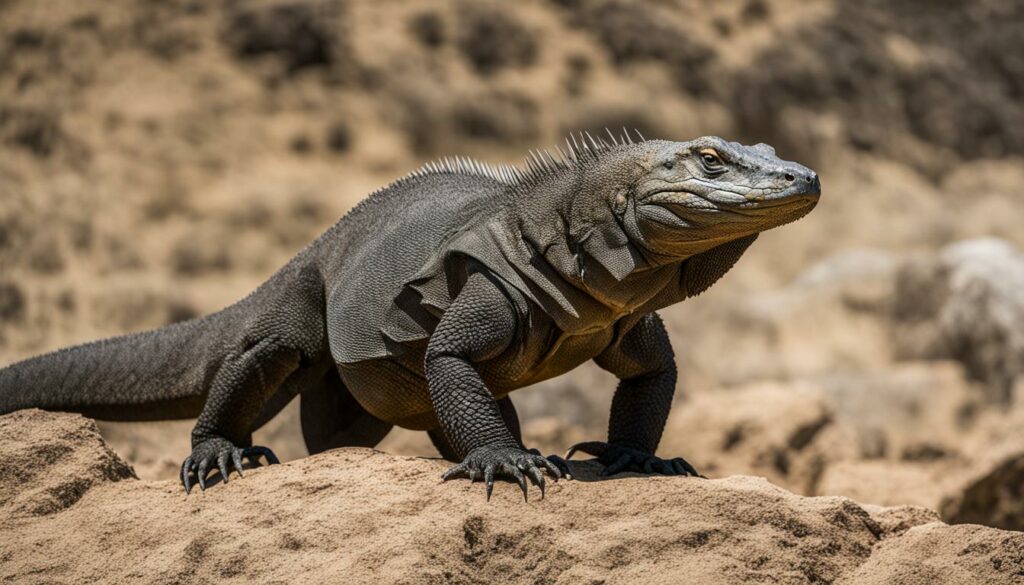
The Importance of Conservation
Conservation not only benefits Komodo dragons but also helps protect the biodiversity of their ecosystems. By preserving their habitats, we can safeguard a variety of plant and animal species that rely on these habitats for survival. The Komodo dragon is not just a symbol of the Indonesian islands; it is also a flagship species, representing the need to protect and conserve the unique and fragile ecosystems in which it thrives.
The extinction of the Komodo dragon would not only be a loss for the biodiversity of our planet but also a testament to our failure to protect and preserve the natural wonders that make our world so extraordinary. It is our collective responsibility to work towards the conservation of these incredible creatures and their habitats.
- Protecting the habitats of Komodo dragons
- Enforcing regulations against habitat destruction and illegal hunting
- Increasing awareness about the importance of conservation
- Collaborating with local communities and stakeholders in conservation efforts
By taking these steps, we can ensure that Komodo dragons continue to roam the Indonesian islands, captivating us with their powerful sense of smell and reminding us of the remarkable wonders of our natural world.
Conclusion
Throughout this article, you have discovered the incredible sense of smell possessed by Komodo dragons. Their olfactory system, including the highly developed Jacobson’s organ and forked tongue, allows them to detect scents from long distances and navigate their environment effectively. This sense of smell is essential for their hunting, communication, and survival in their natural habitat.
The survival adaptations of Komodo dragons, particularly their extraordinary olfactory acuity, showcase their resilience and success as apex predators. Their ability to detect the scent of injured or dead animals from miles away enables them to locate prey even in vast areas. Additionally, their sense of smell plays a crucial role in communication, allowing them to establish territories and identify potential mates.
However, it is important to note that Komodo dragons are currently endangered due to habitat destruction and declining prey populations. Conservation efforts are critical to protect these fascinating creatures and ensure their survival for future generations. Understanding the sense of smell in Komodo dragons emphasizes the remarkable abilities of these reptiles and highlights the significance of preserving their natural habitat.
Does the Sense of Smell Affect the Lifespan of Komodo Dragons?
The fascinating komodo dragon lifespan explained is influenced by various factors, but the sense of smell does not appear to play a significant role. These remarkable creatures, found in Indonesia, have been known to live up to 30 years in the wild. Instead, their long lifespan can be attributed to their strong immune system and relatively low predation rate.
FAQ
What is the scientific name of Komodo dragons?
The scientific name of Komodo dragons is Varanus komodoensis.
Where are Komodo dragons found?
Komodo dragons are found only on the Indonesian islands of Komodo, Rinca, Flores, Gili Motang, and Padar.
How big can Komodo dragons grow?
Komodo dragons can grow up to 10 feet in length and weigh around 200 pounds.
What is the main hunting strategy of Komodo dragons?
The main hunting strategy of Komodo dragons involves stealthy approaches, using their long claws and sharp teeth to deliver a lethal bite.
Are Komodo dragons venomous?
Yes, Komodo dragons have venomous saliva filled with deadly bacteria, which causes their prey to succumb to blood loss or fatal infections.
How many Komodo dragons are left in the wild?
It is estimated that fewer than 5000 Komodo dragons are left in the wild, with some reports suggesting as few as 700-1000 on the island of Komodo.
Why are Komodo dragons classified as endangered?
Komodo dragons are classified as endangered due to habitat destruction caused by human activities and the killing of their prey species by humans.
How do Komodo dragons communicate with each other?
Komodo dragons communicate with each other through scent marking, establishing territories, and detecting pheromones released by females during the breeding season.
What adaptations do Komodo dragons have for their sense of smell?
Komodo dragons have a sensory organ called the Jacobson’s organ, located in the roof of their mouth, and a forked tongue that helps them gather scent particles for analysis.
How does the sense of smell help Komodo dragons survive in their natural habitat?
The sense of smell helps Komodo dragons navigate their environment, locate food sources, and avoid potential dangers in their dense forests, grasslands, and coastal regions.

